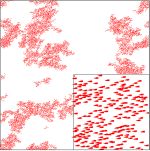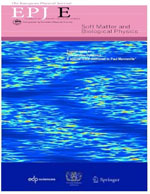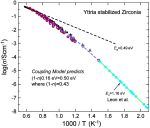News
EPJ D Highlight - Ephemeral vacuum particles induce speed-of-light fluctuations
- Details
- Published on 27 March 2013

New research shows that the speed of light may not be fixed after all, but rather fluctuates
Two EPJ D papers challenge established wisdom about the nature of vacuum. In one paper, Marcel Urban from the University of Paris-Sud, located in Orsay, France and his colleagues identified a quantum level mechanism for interpreting vacuum as being filled with pairs of virtual particles with fluctuating energy values. As a result, the inherent characteristics of vacuum, like the speed of light, may not be a constant after all, but fluctuate. Meanwhile, in another study, Gerd Leuchs and Luis L. Sánchez-Soto, from the Max Planck Institute for the Physics of Light in Erlangen, Germany, suggest that physical constants, such as the speed of light and the so-called impedance of free space, are indications of the total number of elementary particles in nature.
EPJ E Highlight - How proteins read meta DNA code
- Details
- Published on 27 March 2013

Scientists have accurately calculated the sliding mechanism for deciphering the second genetic code written within the DNA base pair sequence
Three-quarters of the DNA in evolved organisms is wrapped around proteins, forming the basic unit of DNA packaging called nucleosomes, like a thread around a spool. The problem lies in understanding how DNA can then be read by such proteins. Now, Arman Fathizadeh, a physicist at Sharif University of Technology in Tehran, Iran, and colleagues have created a model showing how proteins move along DNA, in a paper just published in EPJ E.
EPJ B Highlight - Swarm intelligence
- Details
- Published on 27 March 2013

A new study of animal swarms uncovers some new features of their collective behaviour when overcrowding sets in
Swarming is the spontaneous organised motion of a large number of individuals. It is observed at all scales, from bacterial colonies, slime moulds and groups of insects to shoals of fish, flocks of birds and animal herds. Now physicists Maksym Romenskyy and Vladimir Lobaskin from University College Dublin, Ireland, have uncovered new collective properties of swarm dynamics in a study just published in EPJ B. Ultimately, this could be used to control swarms of animals, robots, or human crowds by applying signals capable of emulating the underlying interaction of individuals within the swarm, which could lead to predicted motion patterns elucidated through modelling.
EPJ E Call for Papers: Irreversible dynamics
- Details
- Published on 17 March 2013

EPJE is now accepting submissions for a topical issue on “irreversible dynamics”, dedicated to Paul Manneville. The study of classical physics underwent a revolution in the 1970s-1980s thanks to seminal contributions by Ruelle, Takens, Pomeau and Manneville. The concurrent revival and extension of the theory of dynamical systems encompasses spatiotemporal chaos and coupled oscillator arrays. Applications to fluid dynamics range from pattern formation in convection, to the onset of turbulence in shear flows. The concurrent revival and extension of the theory of dynamical systems encompasses spatiotemporal chaos and coupled oscillator arrays. Applications to fluid dynamics range from pattern formation in convection, to the onset of turbulence in shear flows. Laurette Tuckerman or Patrice Le Gal, Guest Editors of this topical issue, extend a warm invitation to all researchers, with a wide interpretation of the field. The deadline for submission is July 1st 2013. The full call for papers can be found here
EPJ Data Science Highlight - Shadows over data sharing
- Details
- Published on 17 March 2013

Experience gained from data sharing during the human genome sequencing project could apply to the broader research community
In a paper about to be published in EPJ Data Science, Barbara Jasny, deputy editor for commentary at Science magazine in Washington, DC, USA, looks at the history of the debates surrounding data access during and after the human genome “war”. In this context, she outlines current challenges in accessing information affecting research, particularly with regard to the social sciences, personalised medicine and sustainability.
EPJ B Highlight - Unlocking fuel cell conductivity
- Details
- Published on 17 March 2013

Work on a high-conductivity material demonstrates the role of oxygen ions in enhancing their capabilities
Yttria stabilized zirconia, also known as YSZ, is a material of great interest because of its relatively high oxygen-ion based conductivity. In particular, it finds applications in electrochemical devices, such as solid oxide fuel cells and oxygen sensors. In a study published in EPJ B, Kia Ngai, from the University of Pisa in Italy, and colleagues from the Complutense University in Madrid, Spain, devised a model of the oxygen-ion dynamics that contribute to the conductivity of YSZ.
EPJ D Highlight - New taxonomy of platinum nanoclusters
- Details
- Published on 17 March 2013

The unexpected diversity of metallic nanoclusters’ inner structure has now been catalogued into families
Physicists have gained new insights into the inner intricacies of the structural variations of metallic nanoclusters. This work by Luca Pavan, Cono Di Paola and Francesca Baletto from King's College London, UK, has just been published in EPJ D. It takes us one step closer to tailoring on-demand characteristics of metallic nanoparticles. Indeed, the geometric structure of these nanoclusters influences their chemical and physical properties, which differ from those of individual molecules and of bulk metals.
EPJ B Highlight - Spotting the invisible cracks in wind turbines
- Details
- Published on 23 February 2013

A new approach is available for real-time monitoring of the structural health of wind turbine components during exposure to turbulences.
Physicists have now developed a new method for analysing the elastic characteristics of mechanical structures subjected to disturbances, akin to the turbulences affecting wind turbines. These results have just been published in EPJ B by Philip Rinn and his colleagues at the ForWind Center for Wind Energy Research at the University of Oldenburg, Germany.
A significant percentage of the costs of wind energy is due to wind turbine failures, as components are weakened under turbulent air flow conditions and need to be replaced. The challenge for the team was to find a method for detecting fatigue in the wind turbines’ parts without having to remove each of the components and while the turbine is in operation.
EPJ E Highlight - Gap geometry grasped
- Details
- Published on 10 February 2013

A new algorithm could help understand the structure of liquids, and how they flow through porous media
Theoretical physicist Moumita Maiti and colleagues at the Jawaharlal Nehru Centre for Advanced Scientific Research in Bangalore, India, have now implemented an algorithm for analysing void space in sphere packing, where the spheres need not all be the same size. This method, just published in EPJ E, could be applied to analyse the geometry of liquids present between multi-sized spheres that are akin to a model for porous material. This provides a tool for studying the flow of such fluids through porous material. More importantly, it can also be used to study the packing geometry of proteins.
EPJ Plus Highlight - Simulations’ Achille’s heel
- Details
- Published on 10 February 2013

What can go wrong when computer simulations are applied outside their original context
In an article just published in EPJ Plus, Daan Frenkel from the University of Cambridge, UK, outlines the many pitfalls associated with simulation methods such as Monte Carlo algorithms or other commonly used molecular dynamics approaches.
The context of this paper is the exponential development of computing power in the past 60 years, estimated to have increased by a factor of 1015, in line with Moore’s law. Today, short simulations can reproduce a system the size of a bacterium.





